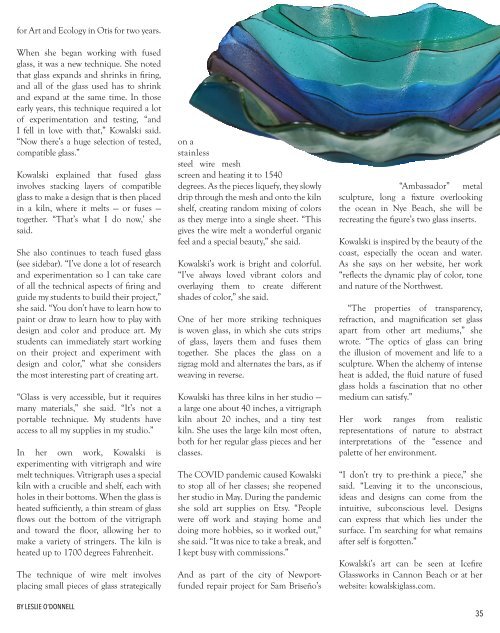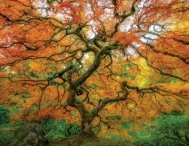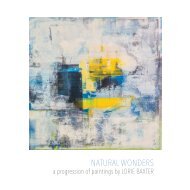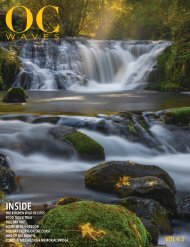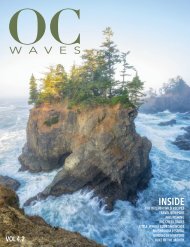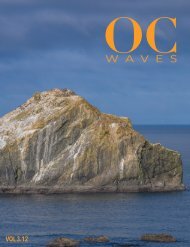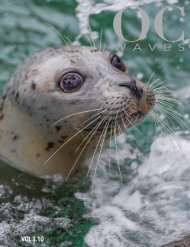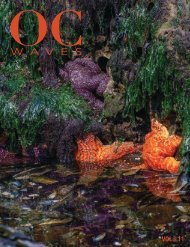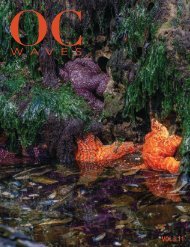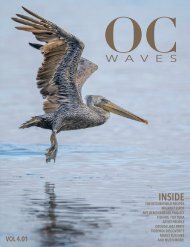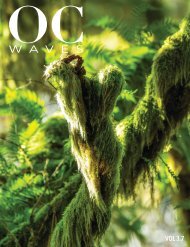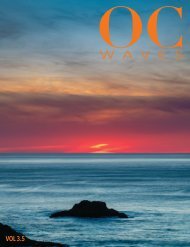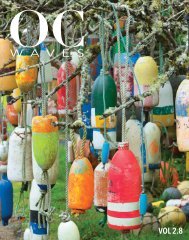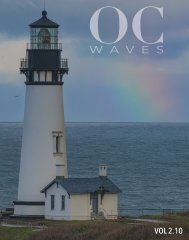You also want an ePaper? Increase the reach of your titles
YUMPU automatically turns print PDFs into web optimized ePapers that Google loves.
for Art and Ecology in Otis for two years.<br />
When she began working with fused<br />
glass, it was a new technique. She noted<br />
that glass expands and shrinks in firing,<br />
and all of the glass used has to shrink<br />
and expand at the same time. In those<br />
early years, this technique required a lot<br />
of experimentation and testing, “and<br />
I fell in love with that,” Kowalski said.<br />
“Now there’s a huge selection of tested,<br />
compatible glass.”<br />
Kowalski explained that fused glass<br />
involves stacking layers of compatible<br />
glass to make a design that is then placed<br />
in a kiln, where it melts — or fuses —<br />
together. “That’s what I do now,’ she<br />
said.<br />
She also continues to teach fused glass<br />
(see sidebar). “I’ve done a lot of research<br />
and experimentation so I can take care<br />
of all the technical aspects of firing and<br />
guide my students to build their project,”<br />
she said. “You don’t have to learn how to<br />
paint or draw to learn how to play with<br />
design and color and produce art. My<br />
students can immediately start working<br />
on their project and experiment with<br />
design and color,” what she considers<br />
the most interesting part of creating art.<br />
“Glass is very accessible, but it requires<br />
many materials,” she said. “It’s not a<br />
portable technique. My students have<br />
access to all my supplies in my studio.”<br />
In her own work, Kowalski is<br />
experimenting with vitrigraph and wire<br />
melt techniques. Vitrigraph uses a special<br />
kiln with a crucible and shelf, each with<br />
holes in their bottoms. When the glass is<br />
heated sufficiently, a thin stream of glass<br />
flows out the bottom of the vitrigraph<br />
and toward the floor, allowing her to<br />
make a variety of stringers. The kiln is<br />
heated up to 1700 degrees Fahrenheit.<br />
The technique of wire melt involves<br />
placing small pieces of glass strategically<br />
BY LESLIE O’DONNELL<br />
on a<br />
stainless<br />
steel wire mesh<br />
screen and heating it to 1540<br />
degrees. As the pieces liquefy, they slowly<br />
drip through the mesh and onto the kiln<br />
shelf, creating random mixing of colors<br />
as they merge into a single sheet. “This<br />
gives the wire melt a wonderful organic<br />
feel and a special beauty,” she said.<br />
Kowalski’s work is bright and colorful.<br />
“I’ve always loved vibrant colors and<br />
overlaying them to create different<br />
shades of color,” she said.<br />
One of her more striking techniques<br />
is woven glass, in which she cuts strips<br />
of glass, layers them and fuses them<br />
together. She places the glass on a<br />
zigzag mold and alternates the bars, as if<br />
weaving in reverse.<br />
Kowalski has three kilns in her studio —<br />
a large one about 40 inches, a vitrigraph<br />
kiln about 20 inches, and a tiny test<br />
kiln. She uses the large kiln most often,<br />
both for her regular glass pieces and her<br />
classes.<br />
The COVID pandemic caused Kowalski<br />
to stop all of her classes; she reopened<br />
her studio in May. During the pandemic<br />
she sold art supplies on Etsy. “People<br />
were off work and staying home and<br />
doing more hobbies, so it worked out,”<br />
she said. “It was nice to take a break, and<br />
I kept busy with commissions.”<br />
And as part of the city of Newportfunded<br />
repair project for Sam Briseño’s<br />
“Ambassador” metal<br />
sculpture, long a fixture overlooking<br />
the ocean in Nye Beach, she will be<br />
recreating the figure’s two glass inserts.<br />
Kowalski is inspired by the beauty of the<br />
coast, especially the ocean and water.<br />
As she says on her website, her work<br />
“reflects the dynamic play of color, tone<br />
and nature of the Northwest.<br />
“The properties of transparency,<br />
refraction, and magnification set glass<br />
apart from other art mediums,” she<br />
wrote. “The optics of glass can bring<br />
the illusion of movement and life to a<br />
sculpture. When the alchemy of intense<br />
heat is added, the fluid nature of fused<br />
glass holds a fascination that no other<br />
medium can satisfy.”<br />
Her work ranges from realistic<br />
representations of nature to abstract<br />
interpretations of the “essence and<br />
palette of her environment.<br />
“I don’t try to pre-think a piece,” she<br />
said. “Leaving it to the unconscious,<br />
ideas and designs can come from the<br />
intuitive, subconscious level. Designs<br />
can express that which lies under the<br />
surface. I’m searching for what remains<br />
after self is forgotten.”<br />
Kowalski’s art can be seen at Icefire<br />
Glassworks in Cannon Beach or at her<br />
website: kowalskiglass.com.<br />
35


